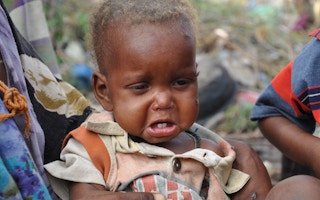Climate-related displacement and food insecurity is not a future possibility, but it is already happening and it’s only projected to worsen without urgent action in coming years.
Ahead of the World Environment Day, the United Nations Refugee Agency (UNHCR) sounded the alarm on the growing impacts of drought in Somalia.
“UNHCR and humanitarian partners fear that severe climatic conditions combined with armed conflict and protracted displacement could push the country into a far bigger humanitarian emergency,” said UNHCR spokesperson Babar Baloch.
As a result of below average rains and a worsening drought, an estimated 5.4 million people are likely to be food insecure by September in many parts of the Horn of Africa nation. Of those, over two million will be in severe conditions and in need of immediate emergency assistance.
“
A doomsday future is not inevitable. But without immediate drastic action our prospects are poor. We must act collectively.
Admiral Chris Barrie, Royal Australian Navy
The drought has also forced nearly 50,000 people to flee their homes in search of food, water, and aid. More than 7,000 were displaced last month alone.
“People who are already displaced because of conflict and violence are also affected by the drought, at times disproportionally,” Baloch added.
The latest crisis is occurring at the wake of a two-year drought that ended in 2017, which displaced over one million.
According to UNHCR, weather-related hazards such as storms, droughts, and wildfires displaced 16.1 million people in 2018.
Climate-related crises are only expected to occur with greater frequency across the world.
In a new, terrifying report, Australian think tank Breakthrough National Center for Climate Restoration warned that climate change poses a “new-to-mid-term existential threat to human civilisation.”
“This policy paper looks at…the unvarnished truth about the desperate situation humans, and our planet, are in, painting a disturbing picture of the real possibility that human life on earth may be on the way to extinction, in the most horrible way,” said Admiral Chris Barrie in the foreword.
The assessment warns that the world’s currently on its way to least 3° Celsius of global warming and projects that by 2050, one billion people in regions such as the Middle East and West Africa will have to relocate due to unliveable climate conditions.
There will also be severe decreases in water availability and a collapse in agriculture and food production.
“The scale of destruction is beyond our capacity to model with a high likelihood of human civilisation coming to an end,” the report states, noting that such climate impacts will accelerate conflict and instability.
But not all hope is lost.
The report urges governments to have strong leadership and mobilise resources “akin in scale to the World War II emergency mobilisation” in order to quickly build a zero-emissions industrial system.
“A doomsday future is not inevitable! But without immediate drastic action our prospects are poor. We must act collectively,” said Barrie.
UNHCR similarly called on more international action to prevent climate-related disasters, increase efforts to strengthen resilience, and protect those already affected by climate change.
Last month, aid agencies launched a 710-million-dollar appeal in response to the drought in Somalia. Only 20 percent has so far been funded.
“With climate change amplifying the frequency and intensity of sudden disasters, such as hurricanes, floods and tornados, and contributing to more gradual environmental phenomena, such as drought and rising sea levels, it is expected to drive even more displacement in the future,” Baloch said.
This story was published with permission from Inter Press Service.










